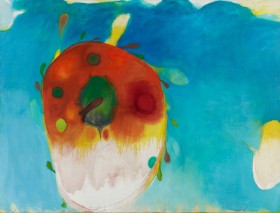EXHIBITION OVERVIEW
Radical. Playful. Iconic. During the 60s, 70s and 80s, Joyce Wieland’s humorous and biting artistry helped give shape to this country’s changing ideas about gender, nationhood and ecology. An artist of great influence, whose work included textiles, collage, print, drawing and film, her legacy lives in the works of subsequent generations.
In this ambitious retrospective, the first since 1987, more than five decades of artistic output come together to highlight the breadth and originality of her practice and to position her as a key figure in 20th century art and film. In addition to situating Wieland’s work in its artistic, social and political context, the exhibition will highlight the many ways she anticipated current debates about feminism, social equity and ecology.
The exhibition is curated by Georgiana Uhlyarik, Fredrik S. Eaton Curator of Canadian Art, AGO and Anne Grace, Curator of Modern Art, MMFA.
Joyce Wieland: Heart On is organized by the Art Gallery of Ontario and the Montreal Museum of Fine Arts.
ABOUT THE ARTIST
Born and raised in Toronto, Joyce Wieland (1930–1998) was one of Canada’s most prominent and prolific twentieth-century artists. Her career in the arts started in the mid-1950s at Graphic Films in Toronto. She spent the late 1950s and early 1960s drawing and painting, and was increasingly included in exhibitions across the country. By 1960, Wieland was represented by The Isaacs Gallery, with whom she continued to exhibit until the late 1980s. Beginning in 1962, she spent a decade in New York City, making assemblages, quilts and experimental films while continuing to show her work. In her filmmaking, Wieland explored a wide array of cinematic modes of expression, from short political films to a full-length feature and documentaries.
Her 1971 exhibition True Patriot Love Véritable amour patriotique was the first by a living woman artist ever held at the National Gallery of Canada. This groundbreaking presentation explored Canadian identity, the North and included a number of textile works, thereby inserting women’s traditional culture and craft into the previously male-dominated realms of the National Gallery and the contemporary artworld. The early 1980s signaled Wieland’s return to figurative drawing and painting. In 1987, the AGO organized her major retrospective, the first such exhibition to be dedicated to a living woman artist in the institution’s history. In addition to creating art in multiple disciplines, Wieland also engaged in social activism, voicing her feminist concerns in a deeply personal and compelling manner. She used humour as a powerful tool of critique, embedding disruptive and unexpected elements and imagery into her work. Throughout her forty-year career, she fiercely defied gender discrimination with a practice that expressed feminist concerns, breaking down boundaries for subsequent artists. Through her work, she also engaged boldly with Canadian politics, environmentalism, American imperialism and Arctic sovereignty.


